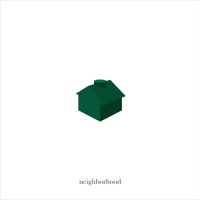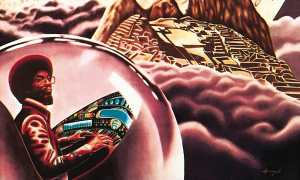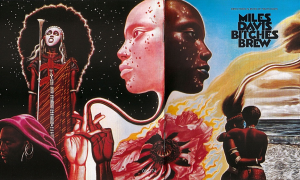Home » Jazz Articles » Rediscovery » Ralph Towner Solstice: Sound and Shadows
Ralph Towner Solstice: Sound and Shadows
 Ralph Towner Solstice
Ralph Towner SolsticeSound and Shadows
ECM Records
1977
While it took the label a year or so to define its raison d'être, by 1970/71 Germany's ECM Records had already garnered significant attention for its pristine, transparent sound, and for beginning to redefine the possibilities of what improvised music could be. A group that seemed ideal for Manfred Eicher's nascent label was Oregon, the American group that was already pushing every envelope by bringing in elements of Indian, classical and folk music (and more) into a heady mélange defined by an unfettered improvisational spirit.
The group's primary composer, Ralph Towner, had already demonstrated a distinctive, pianistic approach to guitar—especially the 12-string variant—that caught many fans and critics' ears when he first appeared as a member of the Paul Winter Consort in the mid-'60s along with three other musicians who would ultimately split off, along with the guitarist/pianist/multi-instrumentalist, to form Oregon in 1970. Oregon's contract with Vanguard prohibited Eicher from bringing the group to his label—it would not happen, in fact, until 1983, after Oregon's Vanguard contract ended and following a three-record deal with Elektra that included another Rediscovery, 1980's In Performance.
Still, it did not preclude Eicher from establishing a relationship with Towner that began with 1972's Trios / Solos—an album that, with all members of Oregon in tow but never all in the pool at once, was really an Oregon album by any other name—and continues to this day, with Towner's most recent Travel Guide (2013) a continuation of the MGT trio he formed with guitarists Wolfgang Muthspiel and Slava Grigoryan a few years earlier.
Towner would go on to record albums for ECM ranging from the overdubbed solo album Diary (1974) to his classic trio date with Eddie Gomez and Jack DeJohnette, 1978's Batik. One album that continues to be considered a high point in Towner's career is, however, Solstice—an inspired pairing with Norwegians Jan Garbarek (saxophones, flutes) and drummer Jon Christensen and German bassist Eberhard Weber—but today's Rediscovery is not the group's exceptional debut, but its second (and, sadly, final) record: Sound and Shadows.
While the quartet's debut is generally considered to be its best, Sound and Shadows is a worthy successor that leverages chemistry gained from touring with a set of five Towner compositions that rival Solstice's three best (the opening "Oceanus," which set a high bar for the group and instantly defined its identity; the darker-hued "Drifting Petals"; and fierier "Nimbus").
Sound and Shadows provides greater opportunity for the group that would become known as Solstice to stretch out, with all but "Along the Way" passing the eight-minute mark. But while the album could be considered a greater blowing session than Solstice, Towner's inimitable writing remains fundamental, and while tracks like "Along the Way" (most tracks, in fact) do follow a "theme-solos-theme" format, the writing is so much more detailed than merely heads written for the purpose of setting up the soloists. And while there are delineated solos, it's Solstice's integration and interaction at a near-mitochondrial level that truly defines it, along with its previously unheard-of mix of instruments and writing that speaks with its own, unparalleled language.
Three of its tracks had either already appeared or would soon show up in Oregon live performances. The opening "Distant Hills" is a more extended look at the title track to Oregon's 1973 Vanguard album that, with Garbarek's sharp-toned tenor, Towner's room-filling 12-string and the sound of Weber's distinctive, custom-built five- string electric double bass, assumes a completely different completion. The classical guitar-driven "Along the Way" and more buoyant piano feature "Arion" would soon end up in Oregon live sets including those documented on In Performance but, with Christensen's signature dark cymbal driving both tunes here, despite being structurally similar their individual ambiences would be completely different. Additionally- -the benefit of being a studio recording—Towner is able to overdub a 12—string guitar solo over his piano on "Arion" and Weber can layer multiple bowed basses on "Distant Hills."
Garbarek's tone and personal complexion/musical aesthetic had already been established on diverse albums like Dansere (ECM, 1976). A particularly lyrical approach to his instrument and remarkable way with a pen made recordings like the bassist's award-winning leader debut The Colours of Chloë (ECM, 1973), and the first of three albums to feature his Colours band, Yellow Fields (ECM, 1975), clear indicators of Weber's already finely honed talent. Christensen's lithe approach to playing with time—and cymbal work that remains influential to this day—had already made him ECM's de facto house drummer, having performed on albums by label artists from Weber, Garbarek and Terje Rypdal to Bobo Stenson, Enrico Rava and Keith Jarrett.
And so, Towner's Solstice group was already something of an ECM supergroup, but what differentiated it from so many collections of name artists—ones that look great on paper but rarely live up to the hype—is that egos were clearly checked at the door, as the quartet turned two other new Towner originals that would not be heard again on record into seminal Solstice tracks: the gradually intensifying "Balance Beam," which featurea Garabrek at his most incendiary; and "Song of the Shadows" where, after a dark-hued opening that brings Weber's bowed bass, Towner's classical guitar and Garbarek's flute together for a more liberated closer, the introduction of Christensen's gentle military snare drives a move into even freer territory, with Towner injecting some French horn into the mix.
Solstice may be looked upon as the classic because it is the introduction of a group with a sound utterly unlike anything heard before, but Sound and Shadows deserves to be held in equal esteem, with its even more developed chemistry and aplomb. That it would be the group's swan song is the biggest shame, but with Towner's commitment to the then-very busy Oregon, and two of its other members leaders in their own right—along with Garbarek and Christensen being increasingly busy members of Jarrett's European "Belonging" Quartet—it just seemed a logistical complexity to keep Solstice alive.
All the more reason, then, to give its two fine recordings the attention they deserve, and to make a point, every now and then, of pulling out and rediscovering superb albums like Sound and Shadows.
So, what are your thoughts? Do you know this record, and if so, how do you feel about it?
[Note: You can read the genesis of this Rediscovery column here .]
Tags
Ralph Towner Solstice
Rediscovery
Ralph Towner
John Kelman
Manfred Eicher
Oregon
Paul Winter
Wolfgang Muthspiel
eddie gomez
Jack DeJohnette
Jan Garbarek
Jon Christensen
Eberhard Weber
Terje Rypdal
Bobo Stenson
Enrico Rava
Keith Jarrett
PREVIOUS / NEXT
Support All About Jazz
 All About Jazz has been a pillar of jazz since 1995, championing it as an art form and, more importantly, supporting the musicians who make it. Our enduring commitment has made "AAJ" one of the most culturally important websites of its kind, read by hundreds of thousands of fans, musicians and industry figures every month.
All About Jazz has been a pillar of jazz since 1995, championing it as an art form and, more importantly, supporting the musicians who make it. Our enduring commitment has made "AAJ" one of the most culturally important websites of its kind, read by hundreds of thousands of fans, musicians and industry figures every month.





















